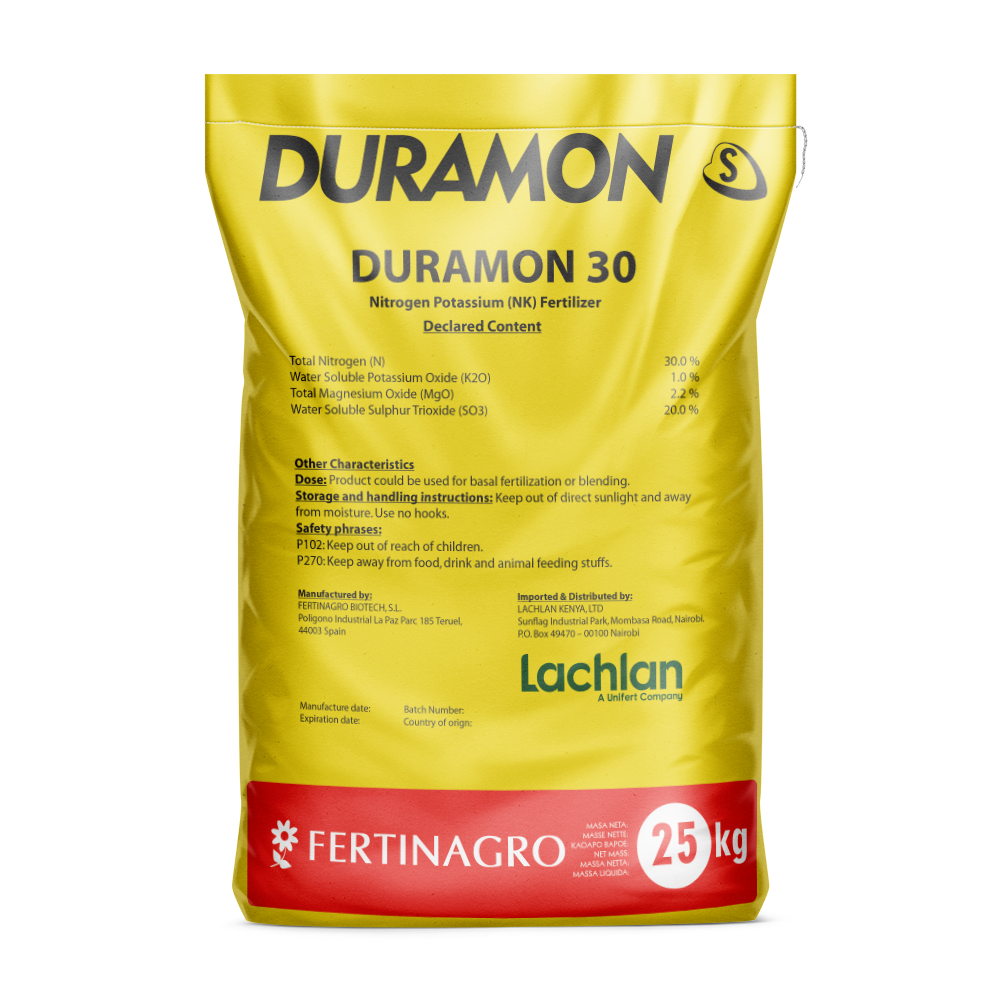Why Duramon 30 is better than CAN
Duramon 30 is a slow release nitrogen fertilizer enriched with sulphur, zinc and magnesium that are necessary for photosynthesis.
Duramon 30 is a slow release nitrogen fertilizer enriched with sulphur, zinc and magnesium that are necessary for photosynthesis.
Multiphos 10-25-0 + TE is a granular Compound NP fertilizer (Chemically Formulated) containing secondary and microelements for direct application to soil or in physical mixtures.
The pest has a 30-174 days lifecycle and can produce 2 to 10 generations in a year laying up to 800 eggs depending on multiple factors including temperature, food availability and quality, and humidity.

Tip burn is a serious problem for growers of leafy vegetables, with dead leaf tips caused by low calcium levels rendering crops unsaleable and reducing marketable yield.
Though the problem areas are usually low in calcium, the cause of that low calcium can be due to either transport or absorption. Both create tip burn in different places and require different approaches for prevention.
Understanding which factor has created the calcium deficiency is the key to growers getting better crops and using their inputs to best effect and not wasting time and money with the wrong approach.
Tip burn caused by transport problems occurs where not enough calcium is available due to lack of movement of water through the tissue. Tip burn can also be caused by absorption problems where calcium is available but cannot be absorbed in the cells due to lack of auxin.
It should not be assumed that the same treatments, application methods, and agronomy can be used on all lettuce varieties, as the shape and growth habit of varieties lead to different reasons for the same tip burn problem. If we split lettuce varieties broadly into closed head and open head, we can see what the drivers for tip burn are, and how they differ.
Closed Head
In closed head lettuce and brassica crops tip burn usually appears in the center. To understand how to deal with the problem we need first to understand the cause, which is lack of calcium transport.
Calcium is not phloem mobile, so crops cannot move it from one part of the plant to another. Calcium moves through the plant with water in the xylem, and parts of the plant where water loss is high have the highest throughput of calcium. Absorption is best where auxin levels are high, as calcium absorption is controlled by polar auxin transport.
In closed-head varieties, the tip burn is occurring in new leaves at the core of the head, where auxin levels are high. This means the problem is not caused by inability to absorb calcium, rather it is caused by lack of calcium transport (the calcium is not getting there).
This is due to water movement, either lack of water movement due to cool moist air leading to little water loss from leaves, or through hot or windy conditions leading to water being drawn to outer leaves and bypassing the core.
In this situation, foliar sprays of calcium will have little or no effect on tip-burn. Calcium applied foliar will not reach the core and will only place calcium in the outer leaves where there is no deficiency to correct. The application of foliar calcium sprays to correct calcium deficiency in the core is a waste of time and money.
To reduce this type of tip-burn then we need to do two things.
1. Ensure adequate calcium is available in the root zone.
2. Manage the crop to maintain even flow of water through the plant.
Agronomic strategy should include managing temperature and air movement to prevent too much water loss from outer leaves, and choosing nutritional products that do not exacerbate the problem. LONO from Lachlan is a product that can be used to supply calcium to the root zone, whilst also supplying stabilised amine nitrogen. Applying calcium this way has the duel effect of making it available where the plant can best transport it to the core, whilst at the same time producing a healthy growth habit and even establishment, a very effective combination for reducing tip burn and increasing head weight. Lono is applied at 5 lts per Ha through the drip.
Loose Head Varieties
In loose head varieties tip-burn typically occurs on the older outer leaves. In this case the condition is not caused by poor water transport, rather it is due to the crop not producing sufficient auxin for applied calcium to be absorbed in the leaf tip. Older leaves are not undergoing active cell division, so any foliar calcium applied to a loose head variety will be absorbed by the newly formed leaves in the center, but not by the older leaves on the outside of the plant.
Again foliar sprays of conventional calcium fertilisers will have a very limited effect on correcting tip-burn. The problem is not due to lack of available calcium (else the rest of the plant would also have tip burn), rather it is due to the plant not being able to absorb calcium in the outer leaf tips.
For loose head varieties a good approach for tip-burn management is to use a more advanced formulation. Lachlan’s ALBION uses chemistry developed by Levity, a UK based scientific company, that allows tissue with a low affinity for calcium absorption like leaf tips to properly absorb calcium. Albina is applied at 1lt per ha, and is proven to reduce tip burn in loose head varieties of lettuce and other salad crops.
Summary
Tip burn can be caused either by calcium transport problems (closed head varieties), or calcium absorption problems (loose head varieties).
Lono manages growth habit, reducing problems with calcium transport and supplies root zone calcium to correct the problem in closed head varieties.
Albion gets calcium into outer leaves where conventional products can’t due to low auxin levels. Foliar applications of Albina are an effective tool to reduce tip burn in loose head lettuce crops.
Duramon 30 guarantees sustainable and long-lasting top dressing. The nitrogen units of the formulas are released gradually, increasing the availability time and reducing losses due to volatilization and leaching.
